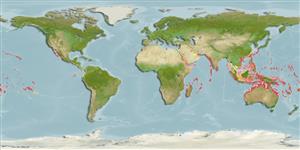>
Eupercaria/misc (Various families in series Eupercaria) >
Labridae (Wrasses) > Corinae
Etymology: Thalassoma: Greek, thalassa = the sea + Greek, soma = body; the colour of the sea (Ref. 45335).
More on authors: Lay & Bennett.
Environment: milieu / climate zone / depth range / distribution range
Écologie
marin récifal; profondeur 0 - 30 m (Ref. 1602), usually 1 - 30 m (Ref. 27115). Subtropical; 24°C - 28°C (Ref. 27115); 30°N - 32°S
Indo-Pacific: Sri Lanka to Ducie Island, north to southern Japan and the Hawaiian Islands, south to southeastern Australia, Lord Howe Island, the Kermadec Islands, and Rapa. Replaced by Thalassoma grammaticum in the tropical eastern Pacific (Ref. 37816).
Taille / Poids / Âge
Maturity: Lm ? range ? - ? cm
Max length : 30.0 cm TL mâle / non sexé; (Ref. 9710)
Épines dorsales (Total) : 8; Rayons mous dorsaux (Total) : 13 - 14; Épines anales: 3; Rayons mous anaux: 11. Body without longitudinal stripes. Initial phase body yellow with light vertical red lines. Terminal phase body abruptly blue to blue-green behind pink and green head. Reddish vertical lines on body. Pectoral fins yellow on basal half, blue to black distally (Ref 9823).
Occurs in groups (Ref. 90102) in clear outer lagoon and seaward reefs, over open sand and rubble as well as dense coral growth. Common is shallow exposed areas (Ref. 9710). Benthopelagic (Ref. 58302). Feeds mainly on shelled benthic invertebrates (crabs, shrimps, gastropods, bivalves, brittle stars, sea urchins), also on polychaete worms and fish eggs. Minimum depth reported taken from Ref. 128797.
Life cycle and mating behavior
Maturité | Reproduction | Frai | Œufs | Fécondité | Larves
Pelagic spawner.
Randall, J.E., G.R. Allen and R.C. Steene, 1990. Fishes of the Great Barrier Reef and Coral Sea. University of Hawaii Press, Honolulu, Hawaii. 506 p. (Ref. 2334)
Statut dans la liste rouge de l'IUCN (Ref. 130435: Version 2024-1)
Menace pour l'homme
Harmless
Utilisations par l'homme
Pêcheries: intérêt commercial mineur; Aquarium: Commercial
Outils
Articles particuliers
Télécharger en XML
Sources Internet
Estimates based on models
Preferred temperature (Ref.
123201): 24.3 - 28.9, mean 27.5 °C (based on 1148 cells).
Phylogenetic diversity index (Ref.
82804): PD
50 = 0.5000 [Uniqueness, from 0.5 = low to 2.0 = high].
Bayesian length-weight: a=0.01000 (0.00611 - 0.01635), b=3.05 (2.91 - 3.19), in cm total length, based on LWR estimates for this species & Genus-body shape (Ref.
93245).
Niveau trophique (Ref.
69278): 3.7 ±0.4 se; based on diet studies.
Résilience (Ref.
120179): Milieu, temps minimum de doublement de population : 1,4 à 4,4 années (Preliminary K or Fecundity.).
Fishing Vulnerability (Ref.
59153): Low vulnerability (20 of 100).
Nutrients (Ref.
124155): Calcium = 34 [16, 74] mg/100g; Iron = 0.585 [0.320, 1.149] mg/100g; Protein = 19.4 [16.5, 21.6] %; Omega3 = 0.217 [0.125, 0.383] g/100g; Selenium = 12.2 [6.0, 24.1] μg/100g; VitaminA = 72.2 [21.6, 300.0] μg/100g; Zinc = 0.907 [0.578, 1.527] mg/100g (wet weight);
